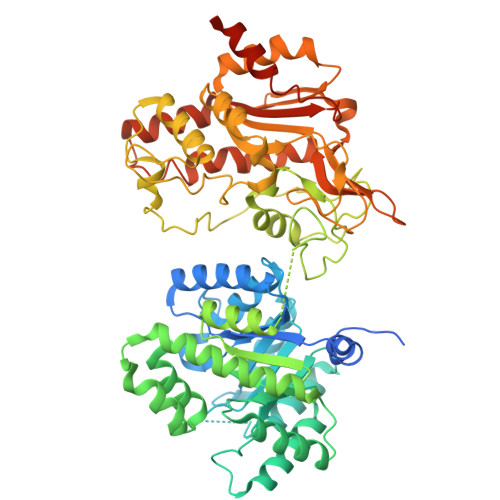Dynamic inter-domain transformations mediate the allosteric regulation of human 5, 10-methylenetetrahydrofolate reductase.
Blomgren, L.K.M., Huber, M., Mackinnon, S.R., Burer, C., Basle, A., Yue, W.W., Froese, D.S., McCorvie, T.J.(2024) Nat Commun 15: 3248-3248
- PubMed: 38622112
- DOI: https://doi.org/10.1038/s41467-024-47174-y
- Primary Citation of Related Structures:
8QA4, 8QA5, 8QA6 - PubMed Abstract:
5,10-methylenetetrahydrofolate reductase (MTHFR) commits folate-derived one-carbon units to generate the methyl-donor S-adenosyl-L-methionine (SAM). Eukaryotic MTHFR appends to the well-conserved catalytic domain (CD) a unique regulatory domain (RD) that confers feedback inhibition by SAM. Here we determine the cryo-electron microscopy structures of human MTHFR bound to SAM and its demethylated product S-adenosyl-L-homocysteine (SAH). In the active state, with the RD bound to a single SAH, the CD is flexible and exposes its active site for catalysis. However, in the inhibited state the RD pocket is remodelled, exposing a second SAM-binding site that was previously occluded. Dual-SAM bound MTHFR demonstrates a substantially rearranged inter-domain linker that reorients the CD, inserts a loop into the active site, positions Tyr404 to bind the cofactor FAD, and blocks substrate access. Our data therefore explain the long-distance regulatory mechanism of MTHFR inhibition, underpinned by the transition between dual-SAM and single-SAH binding in response to cellular methylation status.
Organizational Affiliation:
Division of Metabolism and Children's Research Center, University Children's Hospital Zürich, University of Zürich, Zürich, CH-8032, Switzerland.




















